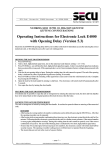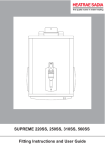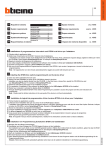Download Operating Instructions Access Timer for Lock Versions 5.2 (up to 5.2
Transcript
Operating Instructions
Access Timer for
Lock Versions 5.2 (up to 5.2.2.1.2)
time at which the electronic lock is to
become operative as described from point
2 under Setting the time, above. Setting
of the time completed, press CH1 again to
store it in the program memory. This will
be acknowledged by the symbol CH1
OFF --:-- appearing on the display.
GENERAL INSTRUCTIONS
Please read these operating instructions very carefully before
you use the safe or the access timer for the first time, to make
sure all technical features are utilized and operating faults are
avoided.
In the control state ON, access to the safe is granted after
entering the pre-selected combination.
In the control state OFF, access to the safe is denied.
When it becomes difficult to read the message on the LCDdisplay, it is time to replace the miniature LR6 alkaline battery.
IMPORTANT: To remedy a blocked electronics due to an
empty battery or incorrect programming (control state permanently on OFF), enter the correct opening combination
twice in a row (despite the signal indicating the blocked
condition). After the safety delay of approx. 72 hours has
lapsed, the safe can be opened after entering the correct
opening combination a third time.
SETTING THE DAY OF THE WEEK AND
THE TIME
1. Keep the key with the clock symbol
pressed during the entire setting procedure!
2. Enter the real time using the h+ (hours)
and m+ (minutes) keys.
3. After keeping the h+ and m+ keys
pressed for more than 2 seconds without interruption, the indication will
automatically run up to the desired
figure.
4. Enter the current day of the week using
the Day key.
5. Now release the clock symbol; the time
is running. (Starting the timer at the
exact second, e.g. to coincide with the
official time signal, is possible!)
6. By pressing the ± 1h key, the clock will
switch back and forth between summer
and winter time.
B. Break-operation programming
The display shows the symbol CH1 OFF
--:--. Now enter the time at which the
electronic lock is to become inoperative as
described from point 2 under Setting the
time, above. Setting of the time completed, press CH1 to store the command in the
program memory.
C. Following the above setting sequences, the 8 make operation
and 8 break operation time settings can be programmed one after
the other.
D. Combining groups of days
To assign a particular day of the week to
the make and break operation time settings, press the Day key the corresponding
number of times. Apart from selecting a
particular day of the week, it is also possible to select a certain group of days:
1. Monday through Friday
2. Saturday and Sunday
3. Monday through Sunday
CHANGING OR CHECKING THE TIME
SETTINGS
To change or check the time settings stored
in the timer memory, press the CH1 key.
The settings will appear on the timer display one after the other. To change a
particular setting, enter the desired time over the old setting as
described unter make-operation programming and break-operation programming, above.
PROGRAMMING THE SWITCHING TIMES
A. Make-operation programming
The access timer can be programmed with up to 8 independent
time frames. A switching-on time ON and a switching-off time
OFF is assigned to each timer. This gives a total of 16 switching
times which are displayed, one after the other, by selecting the
programming mode and pressing the CH1
key.
To select the programming mode, press
CH1 once. Instead of the time, the display
will indicate CH1 ON --:--. Now enter the
Subject to technical modifications
DELETING THE TIME SETTINGS
Timer bis 5.2.2.1.2-Bedienungsanleitung-englisch.p65
If, as a result of entering a new time setting
with the h+ or m+ key, the symbol -appears in the space for the hours and/or
the minutes on the display, it means that
the entry is ineffective, but that it is stored
in the memory as an ineffective part-entry.
page 1
Date: 04.01
CONTROL STATE INDICATION
make operation state, while FIX OFF is
used to select a permanent break operation
state.
The actual control state is indicated by the
terms ON / OFF next to the time on the
display.
Hand symbol ON and hand symbol OFF
are temporary control states, which means
that they are cancelled by the next programmed time setting.
MANUAL SWITCH
SUMMER TIME
The time setting can be changed at any
time without altering the programmed setting stored in the memory by pressing the
key with the hand symbol. The control
states FIX ON, FIX OFF and hand symbol ON, hand symbol OFF will then
appear on the display one after the other.
FIX ON is used to generate a permanent
Using the +1h key, the clock can be turned
to summer time. A further pressing of the
key will allow you to switch back and forth
between summer and winter time. If you
want to enter a time during the summer time period, the display
has to be set to +1h before entering the desired time setting.
Program Example
Below, we will show you how to set the timer if access to the safe is to be granted to all valid combinations Mondays through Fridays
from 6 am to 6 pm (18.00), Saturdays from 8 am to 6 pm (18.00) and Sundays from 9 am until 6 pm (18.00). In our example we will
take advantage of the possibility of combining several days to groups.
KEY
LCD INDICATION
REMARKS
KEY
LCD INDICATION
REMARKS
Enter the hour with the h+ key.
Press CH1 once to program the
first make-operation time 1 setting.
Enter the minutes with the m+
key.
Enter the hour with the h+ key.
Enter Saturday with the Day
key.
Enter the minutes with the m+
key.
Press CH1 once. As the timer is
switched off at 6 pm each day
by Timer 1 OFF (first time
frame selected) anyway, there
is no need to program Timer 2
OFF or Timer 3 OFF in this example.
Enter the required part of the
week Monday through Friday
with the Day key.
Press CH1 once to program the
first break-operation time 1 setting.
Press CH1 once to program the
third make-operation time 3
setting.
Enter the hour with the h+ key.
Enter the hour with the h+ key.
Enter the minutes with the m+
key.
Enter the required part of the
week Monday through Sunday
with the Day key (considering
that the lock has to become inoperative at 6 pm for all three time frames).
Press CH1 once to program the
second make-operation time 2
setting.
Enter the minutes with the m+
key.
Enter Sunday with the Day
key.
Press the clock symbol key to
return to the actual time indication.
page 2
Additional Information for Using the
SECU Access Timer
with the Lock Versions 5.2 (up to 5.2.2.1.2)
SECU's electronic locks E4000, E4000R and E6000R up
to the lock version 5.2.2.1.2 can be supplied in the optional
design variant including an access timer. On the hardware
side, the locks are additionally equipped with a programmable electronic timer which is energized from its own
batteries and mounted inside the inner door panelling in a
separate housing. It provides the user with a means of
defining on a weekly basis up to 8 separate time windows
assigned to freely selectable individual weekdays or specific groups of days, thus giving access to the lock during
the preset times. The access timer will signal the lock
status, i.e. "ON" or "OFF", to the lock and thereby control
the operability of the lock. As the independent power
supply unit of the access timer is also located inside the
enclosed area, it is not possible to manipulate the timeswitch or the programmed settings, for example by resetting
(i.e. disconnecting and subsequently re-connecting) the
batteries of the access timer from the outside.
As a first indication of the batteries of the access timer
becoming depleted (after some years), the time indications
on the LCD gradually lose their intensity and eventually
become invisible. Normally, the battery charge is then still
strong enough for the clock to keep operating for some
months despite the missing LCD indication. However, if
the signs that the batteries are becoming depleted are
persistently ignored, the lack of power will eventually
cause the access timer to fail. In this case, the access timer
will signal a permanent "OFF"-status to the lock and any
attempt at operating the lock will be acknowledged by two
low-pitched signal tones signifying that access is denied.To
make certain that the safe door can nevertheless be opened,
we have devised the "72 hour safety delay" routine. After
having actuated the safety delay routine, the authorized
user has to wait 72 hours before he can open the lock the
direct way, i.e. by entering the valid secret code and thus
circumventing the access timer. Once the door is open, the
user has access to the timer module.
Experience has shown that some users mistakenly actuate
the safety delay routine following an operating mistake
(entering of the code twice in a row during the OFFcondition of the lock). Although you would normally have
to wait until the end of the safety waiting period, it is
possible to cut the unintentionally entered condition
short as follows:
1. Check that the access timer is connected to the lock,
check that the access timer is supplied with power from
the batteries and that it is set in the middle of an opening
time window ("ON-condition").
2. Remove one of the four batteries and immediately put
it back in.
3. The lock will respond with an internal RESET during
the course of which it checks whether the originally
acknowledged operating fault of the access timer still
persists. Provided the verifications under 1., above,
answered positive, the lock will recognize during the
verification procedure that the access timer is again
operating as required and that the actual status is "ON".
Having established this, the lock will end the safety
waiting time of its own accord and continue operating
as usual.
The safety routine is started up as follows:
1. Press the EIN/ON key (you will hear the two lowpitched, "access denied" tones) and, ignoring these,
enter the valid numerical code.
2. Confirm by (momentarily) pressing the ENTER key.
3. Immediately following this, key-in the numerical code
a second time and press ENTER once more. During the
next 72 hours the lock will generally react by sounding
the two "access denied" tones, but it will accept the
valid code and give access to the safe as soon as the 72
hour safety waiting period has lapsed.
Timer bis 5.2.2.1.2-Bedienungsanleitung-englisch.p65
page 3














